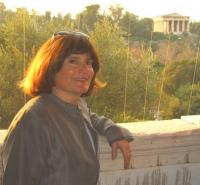 |
|
|
Vanderbilt Professor Unlocks Door to Ancient Greek Houses |
|
By Tom Vogel March 9, 2009 Barbara Tsakirgis, professor of classics and art history at Vanderbilt University, presented a Classical Department Lecture in Memory of the Mary E. McCahill Fund on Friday, March 6. The lecture, titled “Unlocking the Door to the Greek House,” was given in Jeanne d'Arc Auditorium at the College of St. Catherine to a near-capacity crowd. Tsakirgis is a classical archaeologist whose research focuses on Greek architecture and culture. She has participated in excavations in Italy, Sicily and Greece, and her articles have been published in American Journal of Archaeology, Hesperia and Acta Hyperborea. She has received numerous grants and awards, including the Kress Agora Publication Grant and a grant from the Solow Art and Architecture Foundation. |
 Barbara Tsakigris, professor of classics & art history |
|
Tsakirgis, who specializes in the study of ancient Greek living spaces, opened with the observation that there were far more houses than temples in ancient Greek society. Her lecture, she said, was designed to correct the misconception that all of ancient Greece consisted of grand temples. She showed a picture of the Parthenon, and said: “This is the most complete structure you’ll see for the rest of my presentation.” The remainder of the lecture dealt with far more modest structures, many of them little more than a few stones and indentations in the ground indicating where a structure may once have stood. Using excavated materials, as well as ancient texts and images from recovered vases and painted tiles, Tsakirgis recreated a typical ancient Greek domicile, walking the audience though its rooms and explaining the function of each. “We don’t always find buildings filled with their original contents,” Tsakirgis said. “Events occur after people live in a house, such as warfare and looting, which displace the contents.” She showed that when contents are present, it’s possible to map out areas of activity. For instance, vessels for food storage and cook pots discovered in a particular area can help identify it as a place where cooking occurred. Recreating centuries-old houses can be a laborious task, however. As Tsakirgis explained, most finds are in ruin, and the structures — originally made of baked mud — have returned to the earth. “Ritual activity is difficult to reconstruct because the materials used, such as plants, wood, even oral prayer, don’t exist in the archeological world,” Tsakirgis said. She noted that written records are also rare, and reference to household life — especially that of Greek women — is particularly difficult to find. “The records we have are almost entirely from the pens of elite men — men who didn’t spend much time at home — who were not especially interested in talking about the daily activities of women,” she said. That means that this information needs to come from other sources. In her slide presentation, Tsakirgis showed how images from mosaic floor tiles, bowls, drinking vessels and even a primitive highchair have supplemented ancient texts, adding to the understanding of Greek domestic life. Several of the images depict scenes from family life, from births to marriages to funerals, often showing those absent from the literature of the time, namely women and slaves. The lecture ended with an interesting subject from Tsakirgis’ recent studies: recycling in the ancient world. She used the example of a crumbling stone wall, the cracks of which had been filled with shards from roof tiles and even fragments from broken drinking cups, with inscriptions intact. “We think of recycling as a relatively modern practice,” Tsakirgis said. “But the Greeks recycled metal, stone, clay and almost any other materials they could.” Tsakirgis said she hopes her research and instruction will help people realize that much can be gained from the examination of houses. “As we know from our own times, there’s a great deal of insight to be gained from studying peoples’ houses. We can learn how they lived from looking at what they owned.” |
|
|
(Posting date 28 April 2009) HCS encourages readers to view other articles and releases in our permanent, extensive archives at the URL http://www.helleniccomserve.com/contents.html. |
|
|
|
|
2000 © Hellenic Communication Service, L.L.C. All Rights Reserved.
http://www.HellenicComServe.com |
|
